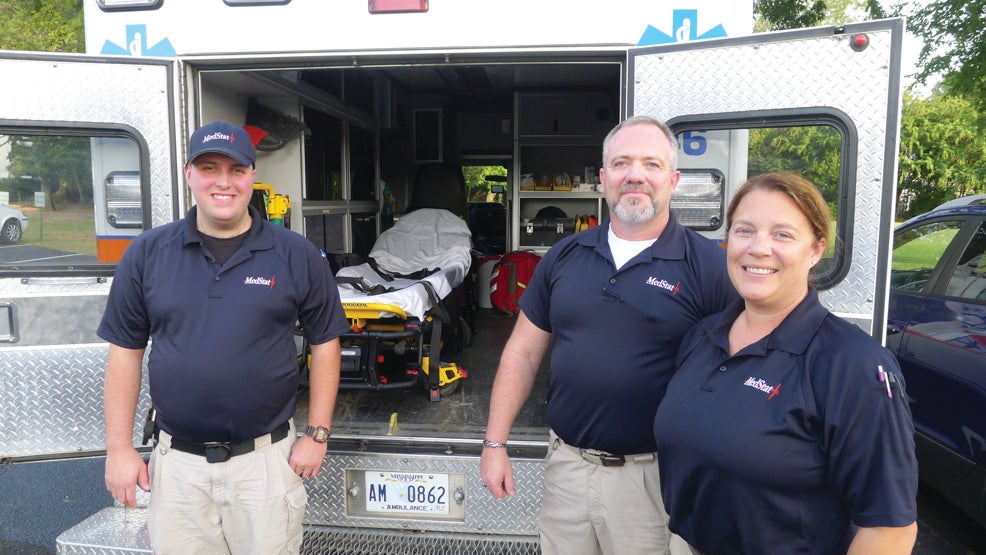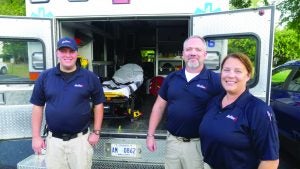Crew describes mobile emergency room
Published 10:32 am Tuesday, October 4, 2016

- MedStat personnel who said they would really appreciate your posting E-911 numbers on your house and locking up your dog if you call them to come in an emergency include (from left) Cannon Moore, James Russell and Laura Smith. The Panolian photo by John Howell

MedStat personnel who said they would really appreciate your posting E-911 numbers on your house and locking up your dog if you call them to come in an emergency include (from left) Cannon Moore, James Russell and Laura Smith.
The Panolian photo by John Howell
Crew describes mobile emergency room
By John Howell
MedStat EMS Ambulance Service personnel offered a primer on ambulance etiquette and practices during recent remarks to the Batesville Exchange Club.
They lamented the lack of E911 house numbers that keep them guessing at the exact location of their destination when precious seconds might mean the difference in life and death. (E-911 house numbers were also addressed in a column in the September 27 edition.)
They said they wished that people who call them would make sure their dogs are restrained when the ambulance arrives.
“It’s not the big dogs,” said Laura Smith. Smith and Cannon Moore joined Northwest Regional Operations Manager James Russell for the visit to the Exchange Club. All three had stories of dog bites.
“The days of grabbing them (patients), throwing them on a stretcher and hauling them to the emergency room, those are long gone,” Russell said. “Emergency medicine has grown dramatically … We can do a lot of things right where we are,” he said, describing the protocol ambulance personnel follow when they arrive at the scene of an emergency
Bystanders are occasionally frustrated with the time that ambulance personnel spend trying to elicit medical information from the patient, according to the MedStat manager.
“There’s going to be a few minutes delay once we get them in the ambulance,” Russell said. “A lot of people think we’re going to throw them in there, shut the doors and take off.”
“There are actually treatments that we’ll be doing in the ambulance before we transport that are necessary. It’ll be a few minutes delay before we transport.”
Smith said that MedStat’s ambulances are equipped comparably to most hospital emergency rooms, with some exceptions.
Russell also described how the hospital destination is determined for the patient.
“We’re going to want to transport the patient to the closest, most appropriate facility,” Russell said. That would mean the Oxford hospital if a heart attack indicated, because of the cardiac unit available there.
Other considerations that determine hospital destination include patient and family requests, within reason. However, the EMT and paramedic would not transport a patient-requested facility that bypassed another facility capable of handling the medical emergency.
“If I have a situation that is detrimental to this patient to be transported that far and bypass facilities that could handle that situation, it could harm the patient,” Russell said.
“Ultimately, the decision is ours,” Russell said. “Our biggest concern is the care of our patient.”
“I may not run lights and sirens with people with heart problems,” Russell said, describing an often misunderstood medical decision that occasionally frustrates patient’s family members. “You’re already nervous, you’re anxious, your heart rate’s going to be up a little bit,” Russell said. The lights and siren might add enough stress to free a blood clot that is already reducing the supply of blood to the heart, according to Russell’s example.
MedStat is paid through private insurance, Medicare and other sources, plus subsidies that each of the 17 counties served, including Panola, provide to offset losses from non-paying patients.
The 20-year-old emergency ambulance service provider operates three ambulance from Batesville and one from Sardis, Russell said.
Other factors that ambulance personnel wish that the public would observe:
• Don’t ride on the tail of an ambulance;
• A family member can be allowed to ride in the ambulance in the passenger’s front seat, but don’t interfere;
• Don’t remain in the left lane when an ambulance approaches from behind with emergency lights engaged;
• Stay off your cell phone when you are driving. “Cell phones are driving me nuts,” Russell said, describing the close calls with drivers talking on cell phones;
• And, don’t forget about those E-911 house numbers and putting up the dog.


